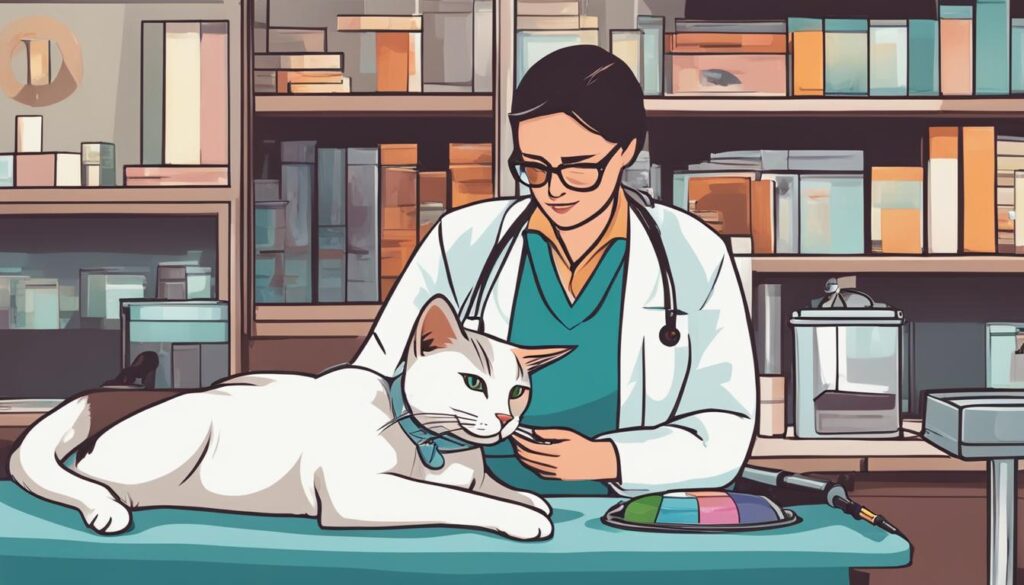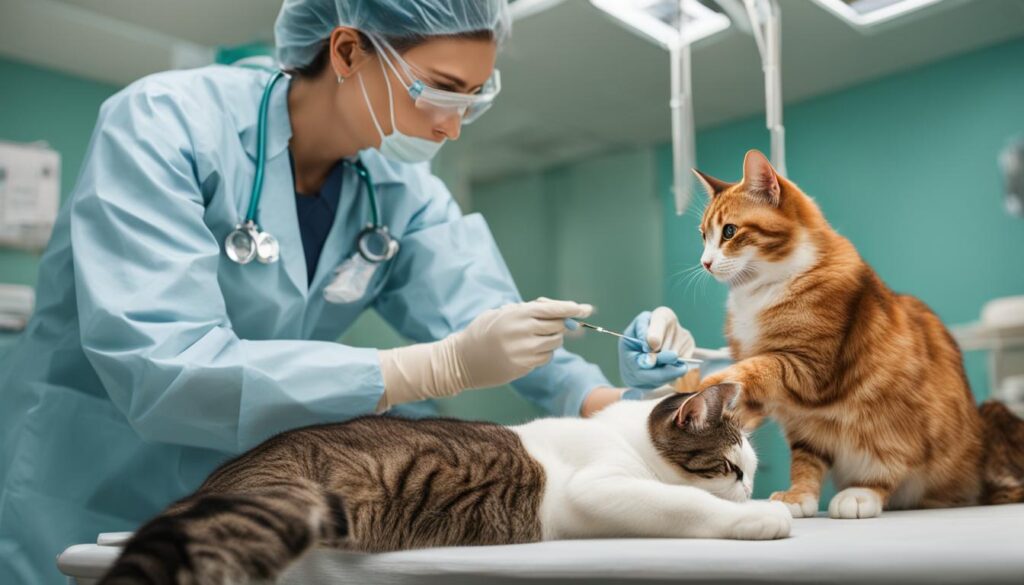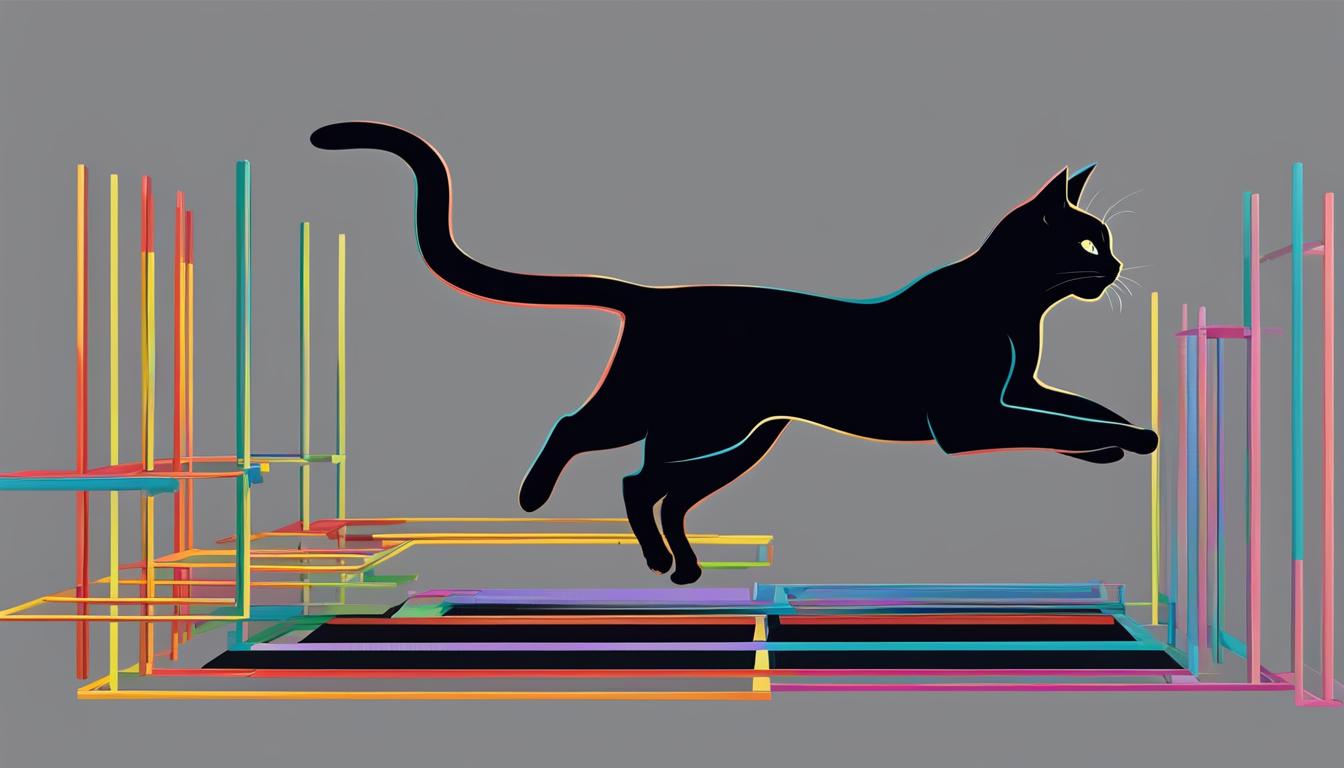Have you ever wondered how your cat’s immune system works to protect them from diseases? Cat immunology is a fascinating field that delves into the intricate mechanisms behind your feline friend’s ability to fight off infections and stay healthy.
Understanding cat immunology is crucial for cat owners, as it can help us provide the best care and support for our furry companions. From the prevention of feline infections to the management of existing conditions, knowing how the cat immune system functions is key in promoting their well-being.
Key Takeaways:
- Cat immunology is the study of how felines fight diseases and stay healthy.
- The cat immune system plays a crucial role in protecting cats from infections.
- Feline infections, such as FIV, can weaken the immune system and leave cats vulnerable to other diseases.
- Proper management can help infected cats live normal, healthy lives.
- Vaccination is an essential tool in promoting feline immunity, but it’s important to make informed decisions based on individual cats’ risk and tolerance.
Understanding FIV Risk and Transmission
Feline immunodeficiency virus (FIV) is primarily spread through bite wounds from infected cats. Casual contact, such as grooming or sharing food bowls, does not efficiently transmit the virus. Unneutered male cats with outdoor access and a tendency to fight with other cats are at the greatest risk of contracting FIV. It is important to note that FIV cannot be transmitted to humans or other non-feline animals.
The prevalence of FIV varies geographically. In North America, approximately 2.5-5% of healthy cats are infected with FIV. However, the risk can be significantly higher in certain populations, such as feral or stray cats. Limiting contact with potentially infected cats by keeping cats indoors and avoiding situations where fights could occur can help reduce the risk of FIV transmission.
Testing all cats within a household is also crucial for managing FIV risk. Cats can carry the virus without showing symptoms, so regular testing can help identify infected individuals and prevent the spread of the virus to other cats. Additionally, neutering male cats can help reduce their tendency to fight, decreasing the chances of transmitting FIV.
“FIV is primarily spread through bite wounds from infected cats, so it is important to keep your cats indoors and avoid situations where fights could occur.”
| Factors | Risk Level |
|---|---|
| Outdoor access | High |
| Unneutered male cats | High |
| Cats that fight with other cats | High |
| Indoor cats | Low |
| Cats from feral or stray populations | High |

Clinical Signs and Diagnosis of FIV
Feline Immunodeficiency Virus (FIV) infection progresses through three distinct phases, each with its own set of clinical signs and diagnostic considerations. Understanding these phases and the associated symptoms is crucial for timely diagnosis and management of FIV in cats.
Acute Phase
The acute phase occurs 1-3 months after FIV infection and is characterized by mild, non-specific symptoms. Cats may experience a transient fever, decreased appetite, and lethargy. These symptoms are often mistaken for a common cold or flu. It’s important to note that some cats may not show any noticeable symptoms during the acute phase.
Asymptomatic Phase
The asymptomatic phase is the longest phase of FIV infection and can last for several years. During this phase, cats appear healthy and show no signs of illness. However, blood tests may reveal abnormalities such as decreased white blood cell counts or persistent lymph node enlargement. It’s important to monitor cats during this phase and conduct regular FIV testing to detect any changes in their immune status.
Progressive Phase
The progressive phase is the final stage of FIV infection and is characterized by a significant decline in the cat’s immune system. Cats in this phase are highly susceptible to secondary infections and may develop chronic illnesses. Clinical signs may include recurring respiratory infections, chronic diarrhea, weight loss, dental issues, and a poor overall condition. Prompt diagnosis and treatment of secondary infections are crucial in managing FIV during this phase.
| Phase | Typical Symptoms |
|---|---|
| Acute Phase | Fever, decreased appetite, lethargy |
| Asymptomatic Phase | No noticeable symptoms, abnormal blood test results |
| Progressive Phase | Recurring infections, chronic diarrhea, weight loss |
Diagnosing FIV involves a two-step process. The first step is screening for FIV antibodies using a ELISA or rapid test. A positive result indicates exposure to the virus but does not necessarily mean the cat is actively infected. Confirmatory tests, such as a Western Blot or PCR, are used to confirm active infection. It’s important to note that false-negative results can occur, especially during the acute phase or in severely immunocompromised cats. Regular testing and monitoring are necessary to accurately diagnose FIV in cats.
By recognizing the clinical signs and understanding the diagnostic process, veterinarians and cat owners can effectively manage FIV and provide the best possible care for infected cats.
FIV Treatment and Management: Ensuring a Healthy Life for Infected Cats
When it comes to FIV (Feline Immunodeficiency Virus) infection, while there is no definitive cure, appropriate treatment and management can significantly improve the quality of life for infected cats. The key to managing FIV is to minimize the risk of secondary infections and prevent the spread of the virus to other cats.
Keeping infected cats indoors is crucial as it reduces their exposure to potential pathogens and minimizes the risk of transmission. Additionally, neutering infected cats can help reduce their urge to fight, decreasing the likelihood of bite wounds and subsequent infections. Feeding a balanced diet and ensuring regular wellness visits are also essential aspects of FIV management.
Supporting the Health of Infected Cats
Infected cats should be promptly evaluated and treated for any signs of illness. Regular veterinarian check-ups are important to monitor their overall health and detect early signs of infections or diseases. Remember, cats infected with FIV may appear normal for years, but their immune system gradually weakens over time, making them more vulnerable to illnesses.
While there are no commercially available vaccines for FIV in North America, limiting exposure to potentially infected cats is the best preventive measure. Vaccines play a crucial role in feline immunity, but in the case of FIV, it is important to weigh the risks and benefits. Always consult with your veterinarian to make informed decisions regarding vaccinations for your cat.
Table: FIV Treatment and Management Recommendations
| Recommendation | Description |
|---|---|
| Keep infected cats indoors | Minimize exposure to pathogens and reduce the risk of transmission |
| Neuter infected cats | Decrease the urge to fight, reducing the likelihood of infections |
| Feed a balanced diet | Support overall health and immune function |
| Regular wellness visits | Monitor health, detect early signs of illness, and provide appropriate care |
| Limit exposure to potentially infected cats | Prevent the spread of FIV |

While living with FIV can present unique challenges, with proper treatment and management, infected cats can lead happy and fulfilling lives. By following these recommendations and working closely with your veterinarian, you can provide the best care and support for your feline companion.
The Role of Vaccination in Feline Immunity
When it comes to protecting our feline friends from infectious diseases, vaccination plays a crucial role in building their immune defenses. But how exactly do vaccines work, and what are the risks and benefits associated with them? Let’s dive into the fascinating world of feline vaccination and explore the intricacies of feline immunity.
Vaccines are designed to stimulate an immune response in cats, triggering the production of antibodies that can recognize and neutralize specific pathogens. This immune memory allows the cat’s body to mount a rapid and effective defense if it encounters the actual disease-causing agent in the future. It’s important to note that while vaccines provide significant protection, they may not offer 100% immunity in all cases. The level and duration of immunity can vary depending on the vaccine and the individual cat’s immune response.
As with any medical intervention, there are potential risks and benefits associated with feline vaccination. On the one hand, vaccines have proven to be highly effective in preventing several life-threatening diseases in cats, such as feline panleukopenia, feline herpesvirus, and feline calicivirus. By vaccinating our feline companions, we can significantly reduce their risk of contracting these illnesses and experiencing severe complications.
On the other hand, vaccines may carry some potential risks. Cats can occasionally experience mild side effects, such as temporary lethargy or soreness at the injection site. In rare cases, more serious adverse reactions may occur, although they are generally extremely rare. It’s important to discuss any concerns or past vaccine reactions with your veterinarian, who can guide you in making the best decision for your individual cat based on their risk factors, tolerances, and overall health status.
In conclusion, feline vaccination plays a vital role in bolstering the immune defenses of our beloved cats. By understanding the mechanisms of feline immunity and weighing the risks and benefits of vaccines, we can make informed decisions to protect our furry companions from preventable diseases. Remember to consult your veterinarian for guidance on the appropriate vaccination schedule and to discuss any concerns you may have. Together, we can ensure the well-being and longevity of our feline friends.

Table: Common Vaccines for Cats
| Vaccine | Disease(s) Prevented | Recommended Schedule |
|---|---|---|
| Rabies | Rabies virus | Initial vaccination, followed by boosters every 1-3 years depending on local regulations |
| FVRCP | Feline panleukopenia, feline herpesvirus, feline calicivirus | Initial series of vaccinations, followed by boosters every 1-3 years depending on individual risk and lifestyle |
| FelV | Feline leukemia virus | Initial series of vaccinations for kittens, followed by boosters for high-risk cats |
Conclusion
Cat immunology is a fascinating field that delves into the intricate ways felines combat diseases. Among the many infectious diseases affecting cats, Feline Immunodeficiency Virus (FIV) stands as a common and significant threat. However, with proper management and care, infected cats can still enjoy a good quality of life.
Vaccination plays a crucial role in bolstering feline immunity. It’s important, though, to carefully consider the risks and benefits of vaccines and make informed decisions specific to each cat. Understanding the principles of cat immunology empowers cat owners to provide the best care and support for their feline companions.
By staying informed about the latest developments in cat immunology, I can make proactive choices to protect my furry friends. I prioritize the well-being of my cats by following recommended management practices, such as keeping them indoors to minimize the risk of secondary infections and the spread of FIV to other cats. Regular wellness visits, neutering, and providing a balanced diet are also essential components of their care.
As I navigate the vast realm of cat immunology, I remain curious about its mysteries. I recognize that not all vaccines provide absolute protection, and the duration of immunity can vary. Moreover, I appreciate how immune response modifiers (IRMs) can enhance feline defense mechanisms. Armed with this knowledge, I can confidently make informed decisions about vaccinations based on my individual cats’ risks, tolerances, and budget.
FAQ
How is FIV transmitted?
FIV is primarily spread through bite wounds from infected cats. Casual contact does not efficiently transmit the virus.
Can FIV be transmitted through casual contact?
No, casual contact does not pose a significant risk for FIV transmission. The virus requires direct blood-to-blood contact, which is most commonly through bite wounds.
What is the prevalence of FIV in healthy cats?
The prevalence of FIV varies geographically, but it is estimated that around 2.5-5% of healthy cats in North America are infected.
How can I reduce the risk of FIV transmission?
Keeping your cats indoors and limiting contact with potentially infected cats can help reduce the risk of FIV transmission. Testing all cats within the household can also be beneficial.
What are the symptoms of FIV?
Cats infected with FIV may appear normal for years but eventually suffer from immune deficiency. Symptoms can range from mild, such as fever and lack of appetite, to more severe, including the development of secondary infections and diseases.
How is FIV diagnosed?
Blood tests can detect FIV antibodies, which are produced in response to the virus. However, negative results may occur in the early stages of infection or in severely immunocompromised cats.
Is there a cure for FIV?
Currently, there is no definitive cure for FIV. However, with appropriate management and care, infected cats can live average lifespans and have a good quality of life.
Are there vaccines available for FIV?
Vaccines for FIV are not commercially available in North America. The best prevention for FIV is limiting exposure by keeping cats indoors and minimizing the risk of secondary infections.
How do vaccines work in cats?
Vaccines aim to create immunity against infectious diseases in cats. They do not provide 100% protection, and the duration of immunity can vary. Immune response modifiers (IRMs) can enhance feline immune responses and defense mechanisms.





